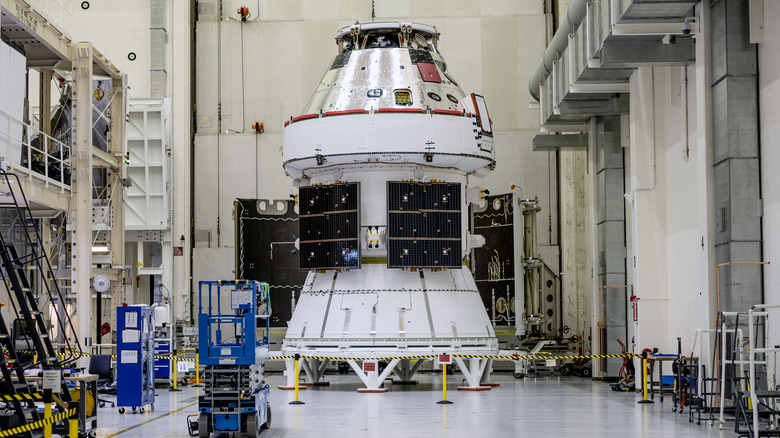NASA's Orion: Everything We Know About The Spacecraft That Will Carry Astronauts To The Moon
NASA has big plans for the next few years, including sending humans back to the moon for the first time in five decades. To do that, the agency is working on a next-generation rocket called the Space Launch System or mega moon rocket, which is almost ready for its first launch as of July 2022. But the rocket is just the launch vehicle — that is, the thing which provides the force to lift off the ground and into orbit. To actually carry humans on such a mission, you need a spacecraft, and NASA has one called Orion up its sleeve.
Orion is a spacecraft designed to sit on top of the Space Launch System rocket and keep the astronauts and their equipment safe on a journey to the moon. The same system is planned to be used for other deep space missions as well, potentially even carrying astronauts to Mars in the future (via NASA). But before any person can set foot in Orion during a real launch, the spacecraft needs to be rigorously tested.
That's why the first planned mission for both the Space Launch System rocket and the Orion spacecraft will be an uncrewed trip around the moon, as part of the Artemis I mission, to make sure everything works as expected before the crew uses Orion as part of Artemis II. Artemis I will take the capsule 40,000 miles past the moon, which NASA says is further than any spacecraft built for humans has traveled before. Currently, the date for the first launch of the uncrewed Artemis I mission is set for no earlier than the end of July or the beginning of August 2022.
The structure of Orion
The main part of Orion is called the crew module or capsule. This is the part where up to four astronauts will stay during missions for up to 21 days. At 11 feet high and 16.5 feet wide, it will have a habitable volume of 316 cubic feet (via NASA). That's not exactly spacious, but it's enough room for four people to live and work for several weeks and to perform the kinds of tasks that are required for a moon mission.
To keep the astronauts inside safe, the capsule is enclosed by a cover that protects it during launch and re-entry, and it is covered with thermal protection tiles to keep out the extreme heat generated by moving through Earth's atmosphere. The crew will also have to deal with the dangers of radiation, although as they will be in space for a few weeks rather than months, this isn't such a danger. Even so, they will have to shelter inside the aft bay of the spacecraft close to the heat shield when radiation poses a threat (via NASA).
To make sure that a variety of body types can safely ride in Orion, the four seats for the crew members are adjustable and designed to fit 99% of the population, even while astronauts are wearing pressure suits which limit their mobility. There are also display screen, physical switches, and hand controllers so that the astronauts can see the status of the spacecraft and interact with it. When Orion returns to Earth, the crew module in which the astronauts stay will separate from the service module that holds the support systems like propulsion and power. Once the spacecraft separates, it will need to move into the right alignment for landing, and for that, Orion has 12 small engines called its reaction control system thrusters.
